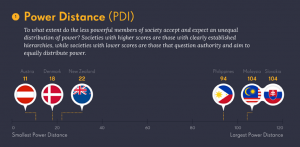Power Distance
Introduction:
For the third week of unit one, we were assigned to explain a widely used professional term using three types of definitions – a parenthetical definition, a sentence definition, and an expanded definition. The objective of this assignment is to build effective communication by defining a term used in the professional setting as there can be many different interpretations and meanings.
Situation:
Power Distance is a widely used term in organizational behaviour studies. The audience will have no knowledge of the term itself. Therefore, I will attempt to explain the term with the following three definitions
- Parenthetical Definition: It Is defined by utilizing familiar synonyms or with clarifying phrases after the term.
- Sentence definition: A more detailed definition by providing a broader class and distinguishing features of the term.
- Expanded definition: For power distance, I will expand through elaborating on its history, operating principal, visuals and examples.
Parenthetical Definition:
In a large power distance (accepting of unequal power distribution) society, parents teach children obedience.
Sentence Definition:
Power distance refers to the extent to which less powerful members of organizations and institutions (including the family) accept and expect unequal power distributions.
Expanded Definition:
History:
In 1995, Hofstede defined power distance as “the extent to which the members of a society accept that power in institutions and organizations is distributed unequally”. The original theory was formed from Hofstede’s global survey on the values of IBM employees between 1967 to 1973. His original theory formed the introduction of cultural differences between people in the business context. He explained that in very high-power distance cultures, the lower-level person will defer to the higher-level person and feel relatively ok as it is the natural order. In lower power distance cultures, everyone expects to be listened to regardless of rank or background, and they will reject autocratic leaders.
How it is used:
Through globalization, it is important to understand the differences between cultures as businesses become more integrated into the global economy. When people are immersed in their own cultures, they often fail to see the patterns and habits that could affect business. Power distance helps us understand how to work with a large variety of people from different countries and cultural backgrounds.
Executive coaches use the theory to help understand the hardships for innovation in high power distance cultures. In these cultures, senior-level people and junior-level people lack communication; hence, the leaders believe they have nothing to improve upon, which leads to slower innovation in the corporate environment.
The differences in perception seem particularly relevant during international business collaborations. For example, Austria has a power distance index of approximately 11, while many Arab nations have indices around 80. With drastic differences in power distance index, employing Austrian business practices or management style in an Arab country may be counterproductive, or result in a degree of culture shock. Executives from a lower index country may open their doors for employees to come in with ideas, but if employees are from higher index countries, they may not knock on the door.
Which countries exhibit high vs. low power distance?

Figure 1: Which countries exhibit the smallest power distance and the largest power distance? (Source: Runaway Suitcase, A Six-Dimensional Model of Cultural Difference)
The primary example of countries with high power distance includes China and Saudi Arabia. They exhibit a characteristic where they believe everybody has a place, which needs no further justification. Particularly in Asian countries, the corporate culture is rooted in deeply held values in the larger culture, which makes it much tougher to shift from the status quo. In comparison, in many of the western countries, such as the United States and Canada, people believe in equalization and distribution of power, and demand change and justification for any inequalities.
Works Cited
“In Asia, Power Gets in the Way.” Harvard Business Review, 23 July 2014, https://hbr.org/2012/04/in-asia-power-gets-in-the-way.
Kenton, Will. “What Is the Power Distance Index (PDI)?” Investopedia, Investopedia, 13 Sept. 2021, https://www.investopedia.com/terms/p/power-distance-index-pdi.asp.
“Examples of Cultural Dimensions.” American Speech-Language-Hearing Association, American Speech-Language-Hearing Association, https://www.asha.org/practice-portal/professional-issues/cultural-competence/examples-of-cultural-dimensions/#:~:text=Power%20distance%20refers%20to%20the,power%2C%20but%20from%20the%20followers.
“Hofstede: The Six Dimensions of Cultural Difference [Overview + Graphic].” Runaway Suitcase, 17 Feb. 2020, https://www.reservations.com/blog/resources/power-distance-index/.
Leave a Reply